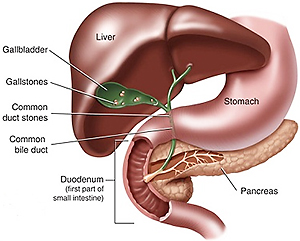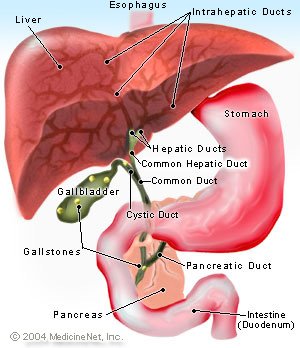
Size
A gallstone's size varies and may be as small as a sand grain or as large as a golf ball. The gallbladder may develop a single, often large stone or many smaller ones. They may occur in any part of the biliary system.
Causes
Researchers believe that gallstones may be caused by a combination of factors, including inherited body chemistry, body weight, gallbladder motility (movement), and perhaps diet.

Symptoms
Gallstones usually remain asymptomatic initially. They start developing symptoms once the stones reach a certain size (>8 mm). A main symptom of gallstones is commonly referred to as a gallstone "attack", also known as biliary colic, in which a person will experience intense pain in the upper abdominal region that steadily increases for approximately thirty minutes to several hours. A patient may also experience pain in the back, ordinarily between the shoulder blades, or pain under the right shoulder. Nausea and vomiting may occur
These attacks are sharp and intensely painful, similar to that of a kidney stone attack. Often, attacks occur after a particularly fatty meal and almost always happen at night. Other symptoms include abdominal bloating, intolerance of fatty foods, belching, gas, and indigestion..
Some people who have gallstones are asymptomatic and do not feel any pain or discomfort. These gallstones are called "silent stones" and do not affect the gallbladder or other internal organs.
Treatment
Surgical options
Cholecystectomy (Gallbladder removal) has a 99% chance of eliminating the recurrence of cholelithiasis. Only symptomatic patients should indicated to surgery. The lack of a gall bladder , however in a significant proportion of the population - between 5-40% - develop a condition called postcholecystectomy syndrome which may cause gastrointestinal distress and persistent pain in the upper right abdomen. In addition, as many as 20% of patients develop chronic diarrhea.
Homeopathic Treatment
Gall Bladder stones can be effectively dissolved with Homeopathic medicines.Results are better if the treatment is started at an early stage soon after the diagnosis. Homeopathic treatment can be a boon to patients who are at high risk surgery such as Aged ones, Hypertensive and Diabetics.